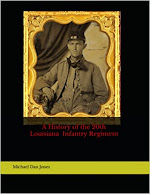Click 👉Today in History (general history) Oct. 15.
On This Day in Confederate History, Oct. 15.
1863: Confederate
submarine C.S.S. Hunley tragically sank during a training accident in
Charleston Harbor, S.C. drowning its inventor Captain Horace Hunley, and
seven other crew members. The other crewmen who died in that sinking were Robert Brockbank, Joseph Patterson, Thomas W. Park, Charles McHugh, Henry Baird, John Marshall, and Charles L. Sprague. There was also a prior sinking in a training exercise in which five crewmen died and three survived.
Also on this day, the second day of the Battle of Buzzard's Prairie, La. takes place. Early in the morning of the 15th of October, Brig. Gen. Tom Green advanced the 4th, 5th, and 7th Texas cavalry regiments to a plantation fence bordering the prairie. He placed Semmes' Battery on the left and the Valverde Battery on the right. Col. William Polk "Gotch" Hardeman of the 4th Texas, led a contingent of skirmishers, made up of one company from each regiment, out onto the prairie to lure two Federal divisions into attacking the strong Confederate position. General William Franklin took the bait and ordered out Brig. Gen. Godfrey Weitzel's Division to attack across the open prairie, supported by artillery batteries. Advancing in full battle order with flags flying, the Federals crossed the prairie and easily pushed the Confederate skirmishers back to the fence line.
The horse soldiers of the 4th, 5th, and 7th Texas cavalry regiments then made a wild dash and full-throated "Rebel Yell" on the right of Weitzel's line. The soldiers from New York and Massachusetts became panic-stricken and the Yankee right collapsed. Coming to the rescue for the Federals was Lt. William Marland of Nim's Battery who stopped the rout and drove the Confederates back with grape and canister, as well as exploding an ammunition chest of Semmes' Battery.
Confederate General Birthdays, Oct. 15.
Major General Thomas Lafayette Rosser was born on this day in 1836 in Campbell County, Virginia. He attended West Point but left in 1861 to enlist in the Confederate Army as a first lieutenant and commanded the Second Company, Washington Artillery of New Orleans in the First Battle of Manassas. Rosser rose through the ranks to major general by November 1864. His battles included First Manassas, the Seven Days Battles, Mechanicsville, Second Manassas, South Mountain, Sharpsburg, Kelly's Ford, Hanover, Gettysburg, the Wilderness, Trevillian Station, Cedar Creek, Tom's Brook, Petersburg, Appomattox. After the war, he worked for an express company, and a railroad, worked to have Confederate monuments constructed, bought a plantation, and was a brigadier general of U.S. volunteers in the Spanish-American War. Rosser died March 29, 1910, in Charlottesville, Va., and was buried there in Riverview Cemetery.
Brigadier General Henry Harrison Walker was born on October 15, 1832, in Sussex County, Virginia. He graduated from West Point in 1853 ranking 41st in a class of 53 cadets. Walker resigned from the U.S. Army on May 3, 1861, and joined the Confederate Army and served as the lieutenant colonel of the 40th Virginia Infantry. He was appointed a brigadier general on July 1, 1863. His battles included Gaines' Mill where he was wounded twice, Bristoe Station, Mine Run, lost a foot at Spotsylvania Court House, Siege of Petersburg, and was paroled May 7, 1865. Following the war, Walker became a stockbroker in New Jersey and died March 22, 1912, in Morristown and was buried there in Evergreen Cemetery.







































No comments:
Post a Comment